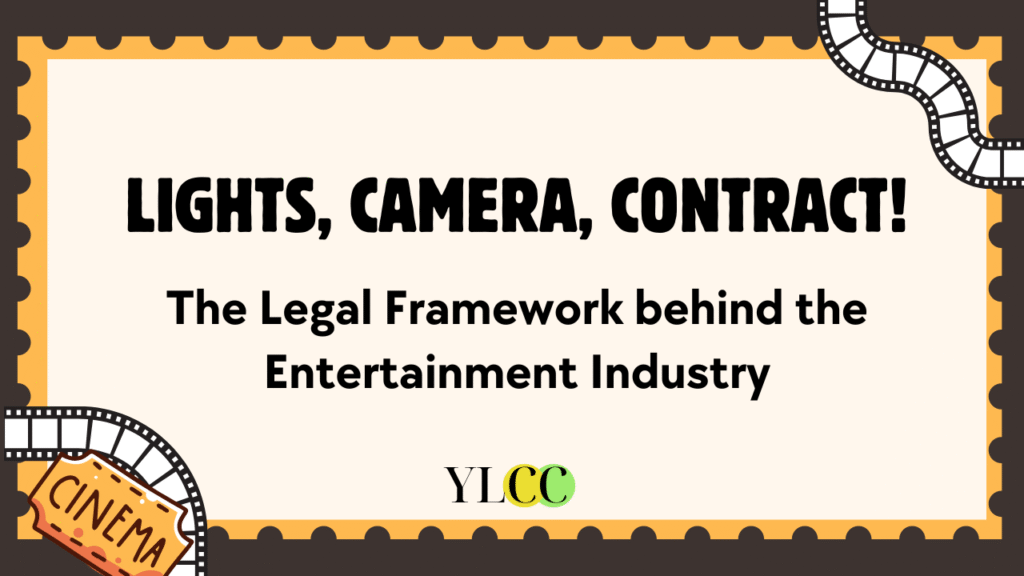
Introduction:
In the fast-paced industry of media and entertainment, legal contracts play a major role by diligently outlining all the terms and conditions of different types of agreements. By laying down such thorough terms, these contracts ensure that disputes and misunderstandings between parties are reduced. These contracts, used in the media industry are called media contracts. Intellectual Property is an essential element in the media industry. Hence, media contracts ensure that they specifically define ownership, safeguarding the intellectual property rights of the actual creators and providing them with control over it. Media Contracts, in general, include provisions for exemption from liability, insurance, etc., protecting the parties involved in the media industry from unanticipated events and potential legal proceedings. The principal use of such a contract is to prevent unauthorized use of IP and protect the integrity of the industry. [1]
Media lawyers need to be well-versed in the various types of media contracts because the media and entertainment sections are heavily influenced by and governed by various laws. These laws govern the different aspects involved in the media industry such as employee relations, business structure, contractual agreements, etc. Hence, different companies must adhere to such contracts and operate in accordance with the law.
Types of Media Contracts:
In a world where creativity meets commerce, media contracts are established just for formality. They are the essential element defining relationships between artists, producers & stakeholders and securing Intellectual Property. Understanding the various types of media contracts is necessary for the success of the entertainment industry. Here are 10 different types of media contracts every media lawyer must know:
1. Licensing Agreements:
This type of contract defines the terms and conditions for the use of Intellectual Property. Generally, this type of contract exists when one party intends to utilize the other’s work for a price (payment). Licensing agreements outline how long one can use the licensed item, how one can and cannot utilize it, and the consequences of breaking the agreement’s terms. [2]
For example, when Nestle and Starbucks in 2018, entered into a coffee licensing deal where Nestle (the licensee) agreed to pay $7.15 billion in cash to Starbuck (the licensor) in exchange for an exclusive right to sell particular Starbucks products such as single-serve coffees and bagged beans. [3]
2. Distribution Contracts:
Distribution Contracts are an important aspect in covering how content will reach its audience and at the same time generate royalties. They are regarding OTT platforms. Here, the contract is generally entered between a production company and a streaming platform. These contracts are essential as they brief about the terms and conditions under which different types of content such as TV shows, movies, music, etc., are distributed in the sense, made available to the public audience. This contract includes different elements such as geographical extent, revenue sharing, duration, etc.[4]
For example, Amazon Prime (the distributor), a video streaming platform entered into a distribution contract with Euros International, allowing its selective films to be streamed on Amazon Prime reaching a wider audience.
3. Production Contracts:
Production Contracts are major contracts involved in the smooth and hassle-free execution of movies and TV shows. It is a contract between various members of the production crew such as producers, directors, and other parties. It outlines the various terms such as funding arrangements, rights acquisition such as acquiring the rights to script, music, duration of the project, IP ownership, etc. [5]The basis behind such a contract is that it covers the responsibility of the crew minimizing any obstacles in the project’s production.
For example, deciding what type of film is produced—whether a short film, documentary, etc.
4. Talent Contracts:
Companies like hiring agencies or production companies seek out talent for their projects. This is when talent contracts come in handy. It is a formal agreement between artists like actors, musicians & models seeking gigs and agencies hiring their services. In such a contract, performance expectations are outlined which include—royalties, nature of work exclusivity terms (whether those artists can work elsewhere alongside), and IP ownership of the artist such as recordings and images. 3
For example, when Hritik Roshan signed a talent contract with YRF (Yash Raj Films) for the movie War released in 2019.
5. Co-Branding Agreement:
A co-branding agreement is a type of contract that is trademark-centric in an entertainment industry where two or more brands agree to collaborate to market or sell their products typically in a movie. These brands have tie-ins with movies and TV shows. [6]
For example, the famous collaboration between GoPro, an action camera brand, and Red Bull, a beverage brand is an excellent example of a co-branding agreement. With this collaboration, they conducted the Red Bull Stratos project where, Felix Baumgartner, a daredevil and a skydiver’s record-breaking jump was captured in GoPro’s action camera.
6. Copyright Assignment Agreement:
This is a legal contract between two or more parties where the copyright owner (assignor) transfers the ownership rights of the word to another party (assignee). The assignor can grant the assignee either to distribute, use, or produce the copyrighted work. Having such an agreement ensures there is a clear definition of terms hence avoiding further potential disputes. The Copyright Act, of 1957 governs such an agreement regarding copyrights and copyrighted works. [7]
For example, any author can enter into a copyright assignment agreement with a publishing company to publish, modify, and distribute his work. The author can grant such rights in exchange for consideration or royalty.
7. Non-Disclosure Agreements (NDAs)/Confidentiality Agreements:
One of the most important agreements used in the entertainment industry is the NDA. The formation of such a contract is to not reveal certain details to anybody outside the contract. NDAs are used to protect information generally against the competitor or rival parties. Confidentiality Agreement, on the other hand, is used for protection of information of a higher importance such as not revealing the name of a producer for a particular duration. The goal of NDAs and Confidentiality agreements overall is the one and the same with minor differences. [8]
During the production and shooting of a film or a TV show, there is certain information, if revealed would ruin the suspense and plot of an entire show. One example is, at the time of Marvel’s awaited release of the movie Avengers: End Game, if a major plot twist of Iron Man’s death was revealed before its release, it would affect them negatively. Hence NDAs and confidentiality agreements would be signed by the actors of the film.
8. Music Publishing Contracts:
In the entertainment industry, music is a very important element used in different types of media such as films, records, television, radio, and video games. Here, the writer is the creator of the music who can assign the rights to the publisher who decides when and where the music should be used. In certain circumstances, the writer himself can be the publisher managing the music by himself. Both the parties here can earn their revenue by broadcasting the music or by reproduction of such compositions. A well-drafted music publishing contract should include—the extent of rights of the assignee, consequences of exploitation, the extent of authority with regard to promotional activities, assessment of royalties, etc. [9]
For example, Arijith Singh, a popular independent singer grants rights to T-series, a music label. A few popular songs included here are “Tum Hi Ho” and “Channa Mereya”. Now T-series can use the rights and publish the songs on its platforms and gain revenue. An amount is paid to Arijith Singh for the rights to his song along with a percentage of profits of the revenue generated.
9. Adaptation License Agreements:
An adaptation License is a legal contract entered when a licensee intends to create an adaption of an already existing copyrighted work that is owned by the licensor. The formation of this contract grants the licensee to make a completely new format of the copyrighted work that is legally authorized. Such type of contract ensures that the original work’s IP is protected. Adaptation in this sense means conversion of an existing novel to a screenplay or an existing film to a stage play. [10]
For example, the very well-known novel series by J.R.R Tolkien—“The Lord of the Rings” is a fantasy fiction novel of 3 volumes that was successfully transformed into a 3 part movie (trilogy). To adapt the novel into a trilogy, an adaptation license agreement was formed which gave the producer the rights to bring the novel into real-life action.
10. Life Story Rights Agreement:
Life story rights agreements are also known as life rights agreements. It is a legally binding contract allowing one party, generally the producer or filmmakers to adapt the life of a person into a media of different forms—novels, movies, shows, documentaries, etc. With such an agreement’s effect in place, the individual whose story is being used can authorize the filmmakers to use their name, character, and other elements in the work. This contract also minimizes legal proceedings from defamation and invasion of privacy as the authorization to depict the life story is already received as agreed upon. [11]
A famous example is the Hollywood movie, “Pursuit of Happiness” starring Will Smith—which is based on a homeless father, Chris Gardner. He was granted the right to adapt his life story into a legally authorized movie. [12]
Key Clauses to be included in an Entertainment Contract:
The main objective of a contract must be to ensure that both parties have fair agreements that are mutually agreed upon. No provision should be favouring either parties majorly. Here are some key clauses that are included in a media contract—
1. Compensation & Royalties:
These are significant elements that need to be included in a media contract ensuring that both the parties of the contract are on a mutual agreement about payment terms. It outlines how much is to be paid, how it is to be paid (lump sum, instalments, etc.), and whether any additional payments such as royalties or bonuses are to be paid.
2. IPR & Ownership:
It defines who owns the intellectual property rights of the works and who can use the same. This clause also defines whether the rights are completely transferred or retained by the original creator.
3. Exclusivity & Non-Compete Clauses:
This clause is specifically added to protect the interest of the hiring party. The exclusivity clause prevents the artist from working elsewhere in a similar field while they are already working for the party to the contract. Non-Compete clauses on the other hand ensure that the artists don’t work for entities that could possibly cause a conflict of interest. The legal professional while establishing such a clause should ensure it is not overly restrictive hence protecting the artists as well.
4. Termination and Nullification:
These clauses ensure include all the aspects with regard to ending the contract. It can include elements like—force majeure events (unforeseen circumstances), breach of contract, IPR & ownership rights after termination of the contract, damages to be paid if any, etc. [13]
Conclusion:
Media contracts are more like the backstage crew of a blockbuster movie. Their work often goes unnoticed, but their impact is significant. Without the crew, the movie wouldn’t even be a blockbuster. Thinking about it, one can say that creativity thrives on chaos, but without the element of control—it becomes a wrecking ball. In simple terms, it means, contracts allow room for creativity without the fear of legal action. Hence it can be said that media contracts act like guardrails to artists and producers letting them know they have a solid foundation to rely on. When a director decides to adapt a novel or a real-life story into a live-action film or when a streaming platform releases a new web series—it is these carefully drafted agreements that act behind the scenes to achieve the artistic possibilities. In conclusion, one can say that media contracts might not be the star on a red carpet but it definitely is they are the backbone as well as the reason creativity comes to the spotlight.
[1] Khurana & Khurana, “An Overview on the Types of Agreements in Media and Entertainment Law”, Mondaq (July 7, 2023) accessed on 24 February 2025 <https://www.mondaq.com/india/broadcasting-film-tv-radio/1338750/an-overview-on-the-types-of-agreements-in-media-and-entertainment-law>
[2] “The Importance of a License Agreement: A Step-by-Step Guide to Drafting Your Procurement Plan”, Oboloo (June 9, 2023) accessed 24 February 2025 <https://oboloo.com/the-importance-of-a-license-agreement-a-step-by-step-guide-to-drafting-your-procurement-plan/>
[3] Corporate Finance Instituion, “Licensing Agreement” <https://corporatefinanceinstitute.com/resources/accounting/licensing-agreement/>
[4] Maithli Jha, “Contractual Agreements in the Entertainment Industry, Corpbiz” (June 23, 2023) accessed 24 February 2025 <https://corpbiz.io/learning/contractual-agreements-in-the-entertainment-industry/>
[5] Maithli Jha, “Contractual Agreements in the Entertainment Industry, Corpbiz” (June 23, 2023) accessed 24 February 2025 <https://corpbiz.io/learning/contractual-agreements-in-the-entertainment-industry/>
[6] G. B. Vishwa, “Legal Intricacies in the Entertainment Industry: A Contractual Perspective”, JLRJS (2)(3) accessed 24 February 2025 <https://jlrjs.com/wp-content/uploads/2023/06/175.-G-B-Vishwa.pdf?utm_source>
[7] G. B. Vishwa, “Legal Intricacies in the Entertainment Industry: A Contractual Perspective”, JLRJS (2)(3) accessed 24 February 2025 <https://jlrjs.com/wp-content/uploads/2023/06/175.-G-B-Vishwa.pdf?utm_source>
[8] Sapna Goundan, “Non-Disclosure Agreements in the Entertainment Industry”, Sprintlaw (May 23, 2022) accessed 24 February 2025 <https://sprintlaw.com.au/articles/nda-entertainment-industry/>
[9] “Music Publishing Contracts:, USLegal, accessed 24 February 2025 <https://entertainmentlaw.uslegal.com/entertainment-contracts/music-publishing-contracts/>
[10] G. B. Vishwa, “Legal Intricacies in the Entertainment Industry: A Contractual Perspective”, JLRJS (2)(3) accessed 24 February 2025 <https://jlrjs.com/wp-content/uploads/2023/06/175.-G-B-Vishwa.pdf?utm_source>
[11] Khurana & Khurana, “An Overview on the Types of Agreements in Media and Entertainment Law”, Mondaq (July 7, 2023) accessed on 24 February 2025 <https://www.mondaq.com/india/broadcasting-film-tv-radio/1338750/an-overview-on-the-types-of-agreements-in-media-and-entertainment-law>
[12] The Editors of Town & Country, “Best Movies Based on True Stories, Town & Country”, Town & Country (January 24, 2025) accessed 24 February 2025 <https://www.townandcountrymag.com/society/g15907978/best-movies-based-on-true-stories/>
[13] Maithli Jha, “Contractual Agreements in the Entertainment Industry, Corpbiz” (June 23, 2023) accessed 24 February 2025 <https://corpbiz.io/learning/contractual-agreements-in-the-entertainment-industry/>
This article has been written by Aishwarya MD. For any other queries, reach out to us at: queries.ylcc@gmail.com






